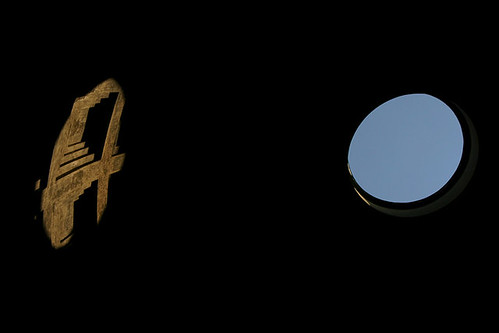I'm kicking myself for not linking to Judith Weingarten's blog post, Time Gazing at the Pantheon in Rome yesterday. It's good explanation of how the Emperor could have used the Pantheon and it's readably short. The only quibble I have is the use of the word sundial. Sundials come in all sorts of shapes, but some shapes are much better suited to being a sundial than others. In the case of the Pantheon in Rome, it's staggeringly well suited to being a sundial. If you wanted to easily create an accurate timekeeper then the Pantheon is the sort of thing you'd want. That's why I don't think it was a sundial in the sense we would think of one - it was too accurate for it to be of any use to the Romans.
To recap from yesterday, the Pantheon is a building with a hemispherical ceiling sat on top of a cylinder. There's a hole in the top which lets in sunlight and the contrast between light and dark creates the effect of a spotlight tracking across the ceiling or walls. It's very simple to convert this into sundial which will tell you the local time. Here's how.
First you'll want a line drawn from the apex of the ceiling due north. This line marks midday. This is because, in the northern hemisphere, the Sun is always exactly south at local noon. Civil time means that it's rarely true for modern people, especially with daylight saving, but local astronomical noon is when the Sun is in the south, which means that spotlight must be in the north. Another line drawn south will mark midnight. Why would you want to mark midnight with a sundial, that's the clever bit, hold on. A line drawn from the apex exactly to the west down the ceiling and wall will mark 6am local time, and one to the east will mark 6pm. You can now fill in the rest of the hours of the day by dropping lines from the apex onto the walls in even divisions. A reason you might want to do this is that the Sun rises in a different place on the horizon at different times of the year. In the northern hemisphere summer the Sun will rise in the north-east before 6am. In our sundial it will cast a spotlight in the south-west before the 6am marker. In the northern winter the Sun will set in the southwest before 6pm. As the sun fell, the spotlight would climb higher up the ceiling, disappearing in the northeast before crossing the 6pm marker.
The clever thing is that this device simply works. You don't have to give any thought to your latitude or longitude. If you built one at Santa's home in Lapland you could see the midnight Sun marked on it. Above the Arctic Circle in high summer the Sun doesn't set. It gets lower in the sky, reaching its lowest point when the Sun is in the north. In our sundial the spotlight would be exactly south, crossing the midnight line. This device would mark twenty-four hours in a day anywhere. That's one reason why I don't think the Pantheon was a sundial, because the Romans didn't have twenty-four hours in a day. They had twelve in the day and twelve at night. Always twelve in the day and always twelve at night. That means that in the summer daytime hours are longer than they are in winter. The Romans knew this, and they also knew that the further north they went, the longer daytime hours were. If they ever made it to Lapland they would have had 'hours' which lasted longer than a day.
You could paint lines on the interior of the Pantheon which marked twelve hours for each day, but it wouldn't be a simple task. The easiest way would be to have someone shout the hours each day and have a painter inside the dome place a dot to connect lines marking either a parabola or hyperbola on a curved surface. If you were building something with the intent of it being a sundial, it would be a lot easier for everyone to relate to if it were sundial shaped.
Still, could it be a precursor to marking a twenty-four equal hours? Looking at the ceiling I don't think so. If you look up you can see the the ancient structure. They do look awfully like the kind of lines I describe marking off the hours. Unfortunately if you can count them without losing your place, you'll see there's a little over twenty-four of them.
If there's twenty-eight columns of coffers, then it's not unreasonable to say there would have been twenty-four if the Romans had been interested in accurate timekeeping. That's why I don't think the Pantheon was used as a sundial on a regular basis.
Pantheon Astronomy II (Sometimes you can be too accurate)







Comments